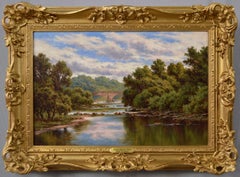Doeford Bridge
19th Century Victorian Landscape Paintings
Canvas, Oil
People Also Browsed
1880s Victorian Still-life Paintings
Canvas, Oil
Early 2000s Old Masters Landscape Paintings
Oil, Canvas
1910s Impressionist Interior Paintings
Canvas, Oil
20th Century Victorian Landscape Paintings
Oil, Canvas
1880s Naturalistic Interior Paintings
Oil
1860s French School Interior Paintings
Oil, Wood Panel
19th Century Victorian Landscape Paintings
Oil
19th Century Victorian Still-life Paintings
Oil, Canvas
18th Century Old Masters Figurative Paintings
Canvas, Oil
1990s Realist Still-life Paintings
Oil, Board
Early 20th Century Academic Landscape Paintings
Oil, Canvas
19th Century Victorian Figurative Paintings
Canvas, Oil
19th Century Landscape Paintings
Canvas, Oil
Late 19th Century Naturalistic Landscape Paintings
Canvas, Oil
19th Century Landscape Paintings
Canvas, Oil
2010s American Impressionist Landscape Paintings
Oil, Panel, Wood Panel
Henry H. Parker for sale on 1stDibs
Born in 1858, Henry H. Parker was a British artist working at the end of the Victorian era. It is believed that he was born and lived in London, where he studied at Saint Martin's School of Art. Parker started his working life as an illustrator for the Illustrated London News, and by the age of 23 had become known as a landscape painter.
Parker's landscapes are lush and tranquil, frequently featuring a lone figure in a boat or walking down a country path. The scenes are often sunny and bright and the waters are calm and soothing.
Parker's style shows a great influence by the Impressionists, through his use of bright colors and quick brush strokes, but a definite understanding of the academic principles is also displayed. This style of painting was very typical for the late Victorian landscape artists who strove to incorporate the new Impressionist techniques in their more traditional paintings. Parker's landscapes and skies were created with a free but controlled application of paint, while the watery areas of his work were handled in the more traditional way — using glazes to create depth and reflections. His paintings are well composed, beautifully balanced and capture the landscape in its most pure and natural state. This colorful and free look was a welcome relief to the traditional Victorian landscapes of the previous decades and this, coupled with Parker's choice of subject matter, brought him great success.
Parker painted mainly in the South East of England, in Surrey, Sussex, and along the Thames where he frequently stayed at Goring and Streatley. He also painted in the Worcestershire area and in Wales. He would often sign and title his works, with their exact location, on the reverse.
Throughout his life, Parker enjoyed widespread popularity as an artist, and this is today witnessed by the number of his works consigned to galleries and museums throughout the world. From 1923 onward, Parker exhibited in the United States, especially in Chicago, where he was unable to meet the demand for his pictures. His paintings were also popular with the Canadians and were hung in all the leading clubs throughout Canada and the States.
Of final note, it is very interesting that Parker was one of only a handful of artists, of his caliber, to never exhibit at the major exhibition halls in England during his lifetime and whose popularity has increased over the years. Parker's works can be found in the following museums and galleries: Birmingham, Liverpool, Eastbourne, Hartlepool, Bradford (England); the Manitoba Club, Winnipeg, St James's, Montreal (Canada); and the Auckland Museum (New Zealand).
Find Henry H. Parker paintings on 1stDibs.
(Biography provided by David Brooker Fine Art)
Finding the Right Landscape-paintings for You
It could be argued that cave walls were the canvases for the world’s first landscape paintings, which depict and elevate natural scenery through art, but there is a richer history to consider.
The Netherlands was home to landscapes as a major theme in painting as early as the 1500s, and ink-on-silk paintings in China featured mountains and large bodies of water as far back as the third century. Greeks created vast wall paintings that depicted landscapes and grandiose garden scenes, while in the late 15th century and early 16th century, landscapes were increasingly the subject of watercolor works by the likes of Leonardo da Vinci and Fra Bartolomeo.
The popularity of religious paintings eventually declined altogether, and by the early 19th century, painters of classical landscapes took to painting out-of-doors (plein-air painting). Paintings of natural scenery were increasingly realistic but romanticized too. Into the 20th century, landscapes remained a major theme for many artists, and while the term “landscape painting” may call to mind images of lush, grassy fields and open seascapes, the genre is characterized by more variety, colors and diverse styles than you may think. Painters working in the photorealist style of landscape painting, for example, seek to create works so lifelike that you may confuse their paint for camera pixels. But if you’re shopping for art to outfit an important room, the work needs to be something with a bit of gravitas (and the right frame is important, too).
Adding a landscape painting to your home can introduce peace and serenity within the confines of your own space. (Some may think of it as an aspirational window of sorts rather than a canvas.) Abstract landscape paintings by the likes of Korean painter Seungyoon Choi or Georgia-based artist Katherine Sandoz, on the other hand, bring pops of color and movement into a room. These landscapes refuse to serve as a background. Elsewhere, Adam Straus’s technology-inspired paintings highlight how our extreme involvement with our devices has removed us from the glory of the world around us. Influenced by modern life and steeped in social commentary, Straus’s landscape paintings make us see our surroundings anew.
Whether you’re seeking works by the world’s most notable names or those authored by underground legends, find a vast collection of landscape paintings on 1stDibs.
